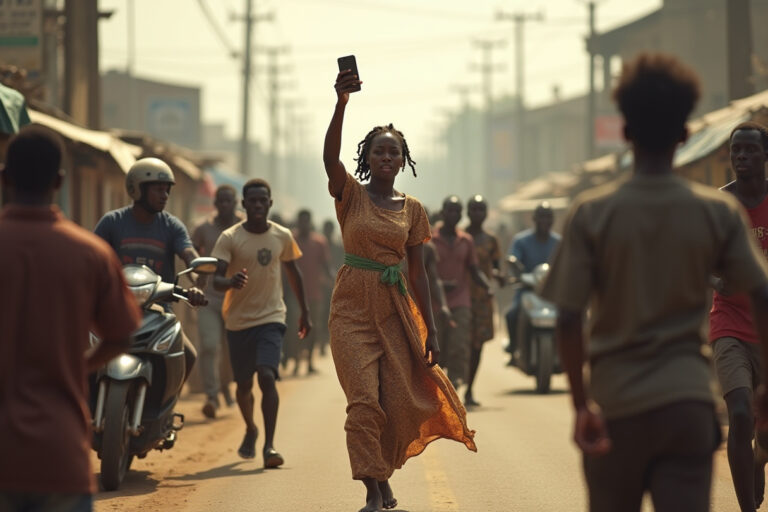The smell of roasted corn drifted through the morning air as motorcycles rumbled past and street vendors unrolled their wares. It was barely 7:00 a.m., but the neighbourhood was already alive with Lagos hustle.
Then, without warning, panic arrived in a wrapper.
Mama Ebun burst out of her compound, barefoot and breathless, wrapper tied carelessly over her chest. She shouted as if something was on fire.
“Everybody go inside! Don’t breathe too deep! Dem don spray something for air!”
Neighbours froze. Phones came out. Faces turned from confusion to alarm.
A young man stepped forward, brows furrowed.
“Mama, who spray wetin?”
She waved her phone. Her hands shook slightly as she held up a screenshot.
“It’s on WhatsApp! My sister just forwarded it. Government dey use drone to spray sleeping chemical, so people go forget to vote!”
The image showed a blurry sky with a red circle drawn around something that could have been a bird, or maybe just a plastic bag. The caption screamed in all caps:
STAY INDOORS. SOMETHING IS HAPPENING. SHARE FAST.
It didn’t take long. Doors slammed shut. Shopkeepers packed up. Okada riders made sharp U-turns. A group of schoolchildren were turned back at the junction. In less than 15 minutes, the street was empty.
All that remained was the hum of uncertainty and the steady ping of forwarded messages.
Two streets away, Zainab sat cross-legged on her mattress, sipping lukewarm tea. Her phone buzzed with the same message. She opened it, sighed, and shook her head.
“Haba. This same video again? They just added Lagos caption.”
She ran a quick image search. The photo was from a protest in Chile four years ago.
No drones. No chemicals. No Nigerian conspiracy.
She put her phone down, annoyed but unsurprised.
By noon, the sun was hot and the lie was still travelling. Outside a kiosk, a small boy tugged at a vendor’s sleeve.
“Aunty, na true say dem go close market tomorrow because of the lizard wey dem catch?”
The vendor didn’t flinch.
“Yes o. My cousin’s neighbour’s son saw it with his own eyes. The lizard even confessed.”
This is how fake news works.
It doesn’t always come in bold headlines or political statements. Sometimes, it’s in a poorly edited picture. Sometimes, it’s in the familiar voice of a trusted friend. And sometimes, it’s in the panic that spreads before the facts arrive.
It shuts down schools.
It sparks fear.
It fuels suspicion.
It damages trust, not just in institutions, but in each other.
The real danger of fake news isn’t just online. It is offline. It is in our homes, our markets, and our daily conversations. Its impact lingers long after the post is deleted.
But here’s the thing. Truth may travel slower, but it always arrives.
Fake news shouts. Truth asks questions.
Fake news demands urgency. Truth waits.
Fake news spreads like fire. Truth walks like water.
So next time a message arrives with all caps and three exclamation marks, take a breath.
Ask:
Where is this from?
Can I verify it?
Who benefits if I believe this?
What happens if I’m wrong?
Before you hit “forward,” imagine Zainab sipping her tea and rolling her eyes.
Would she believe this?
Because while some people’s phones remain the same, their eyes can open.
And that, more than any viral video, is how change begins.





